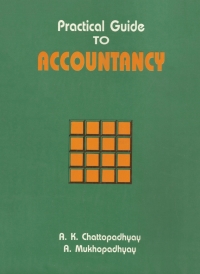Question
1. Assume that the actual amount of one of a companys variable expenses was $45,198. The companys planned level of activity was 19,000 machine-hours, and
1. Assume that the actual amount of one of a companys variable expenses was $45,198. The companys planned level of activity was 19,000 machine-hours, and its actual level of activity was 18,475 machine-hours. The spending variance for this particular expense was $9,114 favorable. The cost formula per machine-hour for this expense is:
-
$1.92.
-
$1.96.
-
$2.88.
-
$2.94.
2. Assume a company is considering using available space to make 10,000 units of a component part that it has been buying from a supplier for a price of $40.50 per unit. The companys accounting system estimates the following costs of making the part:
| Per Unit | 10,000 Units per Year | ||||||||
| Direct materials | $ | 17 | $ | 170,000 | |||||
| Direct labor | 12 | 120,000 | |||||||
| Variable manufacturing overhead | 2 | 20,000 | |||||||
| Fixed manufacturing overhead, traceable | 8 | 80,000 | |||||||
| Fixed manufacturing overhead, allocated | 4 | 40,000 | |||||||
| Total cost | $ | 45 | $ | 430,000 | |||||
One-half of the traceable fixed manufacturing overhead relates to a supervisor that would have to be hired to oversee production of the part. The remainder of the traceable fixed manufacturing overhead relates to depreciation of equipment that the company already owns. This equipment has 20,000 units of unused capacity, no resale value, and it does wear out through use. The allocated fixed manufacturing overhead relates to general overhead costs, such as the plant managers salary, lighting, heating and cooling costs, and plant insurance costs. What is the financial advantage (disadvantage) of making 10,000 units instead of buying them from the supplier?
-
$(20,000)
-
$20,000
-
$(55,000)
-
$55,000
3. Assume the following:
- The standard price per pound is $2.10.
- The standard quantity of pounds allowed per unit of finished goods is 4 pounds.
- The actual quantity of materials purchased was 53,000 pounds, whereas the quantity of materials used in production was 50,400 pounds.
- The actual purchase price per pound of materials was $2.25.
- The company produced 13,000 units of finished goods during the period.
What is the materials quantity variance?
-
$5,460 F
-
$5,850 F
-
$3,600 F
-
$3,360 F
4.Assume the following information appears in the standard cost card for a company that makes only one product:
| Standard Quantity or hours | Standard Price or Rate | Standard Cost | ||||||
| Direct materials | 5 | pounds | $ | 11.00 | per pound | $ | 55.00 | |
| Direct labor | 2 | hours | $ | 17.00 | per hour | $ | 34.00 | |
| Variable manufacturing overhead | 2 | hours | $ | 3.00 | per hour | $ | 6.00 | |
During the most recent period, the following additional information was available:
- 21,200 pounds of material was purchased at a cost of $10.50 per pound.
- All of the material that was purchased was used to produce 3,900 units.
- 8,000 direct labor-hours were recorded at a total cost of $132,000.
What is the direct materials price variance?
-
$9,750 F
-
$10,600 U
-
$10,600 F
-
$9,750 U
5. Assume a companys estimated sales is 32,000 units. Its desired ending finished goods inventory is 8,500 units, and its beginning finished goods inventory is 3,500 units. What is the required production in units?
-
44,000 units
-
28,500 units
-
20,000 units
-
37,000 units
6. Assume that a company provided the following cost formulas for three of its expenses (where q refers to the number of hours worked):
| Rent (fixed) | $3,000 | |||
| Supplies (variable) | $4.00 | q | ||
| Utilities (mixed) | $150 + $0.75 | q | ||
The companys planned level of activity was 2,000 hours and its actual level of activity was 1,900 hours. The actual amount of supplies expense for the period was $7,830. What is the spending variance for supplies expense?
-
$230 U
-
$230 F
-
$460 U
-
$460 F
7. Assume the following (1) variable expenses = $308,000, (2) unit sales = 10,000, (3) the contribution margin ratio = 20%, and (4) net operating income = $10,000. Given these four assumptions, which of the following is true?
-
The total fixed expenses = $61,600
-
The total sales = $369,600
-
The break-even point in sales dollars is $335,000
-
The total contribution margin = $246,400
Step by Step Solution
There are 3 Steps involved in it
Step: 1

Get Instant Access to Expert-Tailored Solutions
See step-by-step solutions with expert insights and AI powered tools for academic success
Step: 2

Step: 3

Ace Your Homework with AI
Get the answers you need in no time with our AI-driven, step-by-step assistance
Get Started


